Dragons are cool. Giant scaly (or feathered) winged beasties, hovering in the skies or lurking in deep, dark caverns. Some are bearers of luck, some wreak havoc with a belly filled with fire. And many seem to be really into sitting around on a giant gold pile (though why is murky—are they hoping to bring back the gold standard?). So, yeah, dragons in fantasy literature are the coolest creatures out there (yes, I know, they can also be extremely hot), and their presence lends a grandeur and majesty to any story. Depending on the story, they may be metaphor for the human condition, they may be aliens we live among, or they may be an existential threat unlike any you’ve ever encountered before.
…Except that not all dragons are like that. In fact, some of the most memorable creatures in fiction stick with us because they are the exact opposite of all of those things we’ve come to expect. So I’ve dug into the hoard—shh, don’t tell them!—and come up with some real gems from across fantasy literature…here are my favorite offbeat, eccentric, and reluctant dragons of unusual ability (and sometimes size).
Errol (Guards! Guards! by Terry Pratchett)
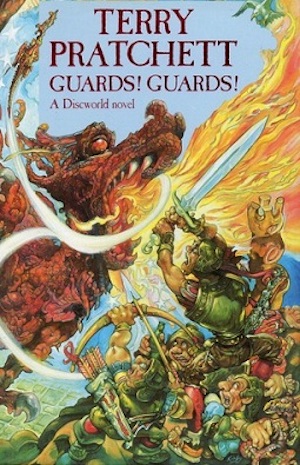
Officially known as Goodboy Bindle Featherstone of Quirm, Nobby nicknamed this swamp dragon Errol and it just kind of stuck. At first, he doesn’t seem like much of a dragon of any sort—swamp or otherwise. Lady Sybil, founder of the Sunshine Sanctuary for Sick Dragons, keeps him as a pet. His face is long and thin, he’s got a lumpy body and enormous nostrils. He doesn’t seem able to make fire or even fly (he’s got wings that are almost as big as his eyebrows).
But Errol turns out to be a dark horse—er, dragon—in the end. When Ankh-Morpork becomes the target of a Noble dragon, Errol springs into action and startles everyone by being, well, a particularly great dragon! Not only can he produce flame (backwards, but still) and sonic booms, but he re-arranges his digestive system to become a supersonic jet engine! After all, the only thing better than a dragon is an unexpectedly competent dragon.
Gork (Gork, the Teenage Dragon by Gabe Hudson)
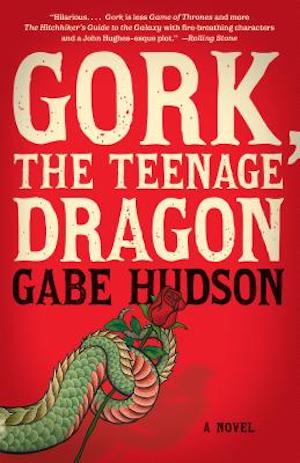
Being a teenage dragon is about what you might expect, even if you only have experience with teenage humans. Gork cares about some things, but he doesn’t care about all of the things he’s supposed to care about as graduation from WarWings Military Academy approaches—namely, convincing a female dragon to agree to be his queen. All he has to do is accomplish that one mission, and then they can go off to a distant world and conquer it together. But if his female dragon of choice turns him down, Gork becomes a slave.
That’s quite a lot to ask from a not-yet-mature dragon who suffers with an oversized heart, with horns that are only two inches long, and who sometimes just… faints. Besides, he’s got his beady eyes set on his one true love already: Runcita Floop, the dean’s daughter—and the dean has no intention of letting Gork pledge his troth. All that aside, Gork also has to battle bullies and a grandfather named Dr. Terrible whose intentions are muddy to say the least. At least he’s got his pal Fribby and a sentient spaceship to help guide him around. Will he succeed? Probably, but not in the way any of us expect.
Ember (Talon by Julie Kagawa)
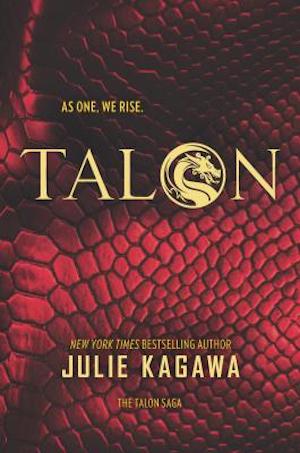
Oh, to be young and in love with a forbidden suitor who kills dragons! But it’s this last bit that’s problematic for 16-year-old Ember (who has a twin, Dante) because, well…she’s a dragon. A premise that could have been farcical is instead the basis for a heartfelt paranormal romance because in this world, dragons are often shape-shifters who look pretty much like the humans sent to wipe them off the face of the earth. As a young dragon, Ember has to convince everyone she can blend in with human society—but then she meets a fellow rogue dragon named Riley and a soldier named Garret who’s part of a dragon-slaying order, and develops a connection with both of them.
Hey, we get it: teen hormones always supersede reason, sense, and the fact that the people you’re mixed up with have been murdering your kin. But Garret is more than the sum of his beliefs, and after watching Ember in action his eyes open to a whole new world. Who says dragons can’t be romantic?
Drogon, Rhaegal, & Viserion (A Song of Ice and Fire by George R.R. Martin)

The dragons of Martin’s expansive Westeros (and beyond) are, in a lot of ways, your typical hot-bellied beasts: They fly, they breathe fire, they have scales and wicked tempers. But in these books, dragons are less likely to be hunted by humans than raised with them. The tradition of setting dragon eggs in the cradle of Targaryen royal children was long established before Daenerys figured out how to hatch three of them in her husband’s funeral pyre. Her hatchlings became the first three dragons born in over a century, and form an immediate bond with the mother who helped birth them—even though she’s puny, scale-less and, well, human.
Though Daenerys is not always able to control their appetites, and at one point she chains up Viserion and Rhaegal—her children!—keeping them underground to pacify locals worried about losing their livestock (or potentially their own sons and daughters), the trio do respond to her commands and obey her, most of the time. After all, they don’t call her the Mother of Dragons for nothing…
Dragon (The Reluctant Dragon by Kenneth Grahame)
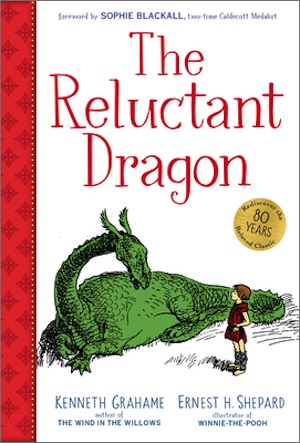
Sometimes dragons just don’t wanna dragon. They’re more the peace-loving sort, who don’t appreciate being considered an object of scorn or fear. They just want to enjoy their poetry and the lovely view and be left alone. This 1898 short children’s story is one of the very first known tales of a sympathetic dragon (though obviously not the last). Neither the dragon nor the boy who befriends him are named, though St. George (noted dragon-slayer) does show up at one point. The boy introduces George to the dragon-who-wants-to-be-left-alone and they agree to hold a fake joust to make the townspeople feel better about having a dragon in their midst. After a bit of thrust-and-parry for show, George announces that the Dragon is of no threat, and he becomes part of the community.
Chrysophylax Dives (Farmer Giles of Ham by J.R.R. Tolkien)
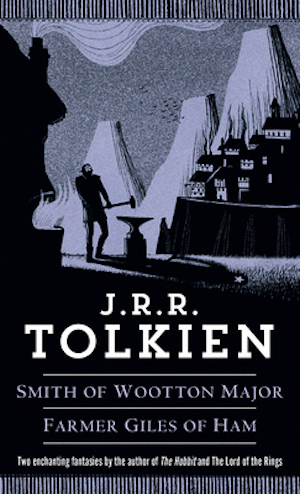
Smaug is hardly the only example of Tolkien dipping into dragon lore—Chrysophylax Dives (whose first name means “gold guard” in Greek, and whose last name means “rich” in Latin) is also fearsome and determined…but definitely does not dwell in the earnest lands of Middle-earth. Instead, these are the satiric, alt-history Dark Ages of Britain, in which a farmer who becomes an accidental hero is gifted with a dragon-thrashing sword. When a curious Chrys shows up to see what mayhem he can create, the farmer is able to take care of him and get the dragon to promise to share his hoard. Tamed by the sword and the farmer’s wit, Chrys ends up living in a barn on the farmer’s property, effectively turned into a bodyguard for the new, wealthy lord of the land.
***
Buy the Book


Tune in Tomorrow
Randee Dawn is a Brooklyn-based entertainment journalist who scribbles about the glam world of entertainment by day, then spends her nights crafting wild worlds of fiction. Her debut novel, Tune in Tomorrow, about a fantastical TV reality show packed with soap opera-style twists, will publish on August 23 (Solaris). Dawn has written for Variety , The Los Angeles Times, Emmy Magazine and Today.com and is the co-author of The Law & Order: Unofficial Companion. Find out more on Twitter, and RandeeDawn.com










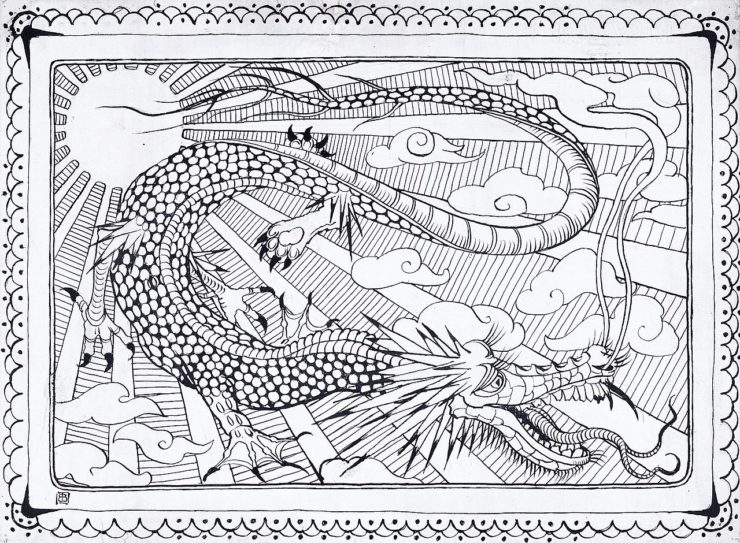
Tui T. Sutherlands WIngs of Fire series is populated by multiple tribes of dragons ranging from the traditionally violent and fire breathing (Skywings) to the pacifist vegetarian (Rainwings) and a host of other unique varieties. I’m not really a dragon aficionado but my kids adore this (17 and counting book) series and it’s pretty fun even for an adult.
It also features bonus utterly matter of fact LGBTQ+ representation.
I’m sure I’m not the only one to think of Jo Walton’s “Tooth and Claw”, in which the dragons may be gold-obsessed cannibals, but they’re also very proper Victorian ladies and gentlemen in the tradition of Anthony Trollope. For whom a social misstep or misfortune can be a fate worse than death. (With no small risk of leading directly to it.)
If poetry, or at least rhyme, is allowed, there’s also Ogden Nash’s Custard the dragon, who cries for a nice safe cage, but comes through when it counts.
The Dragon and the George by Gordon Dickson, where a 1960’s graduate student gets his mind switched with a medieval dragon’s and has to deal with the cranky uncle of the dragon body he’s in, a dragon slaying knight, a wizard with magical Alexa, and a quest to save his lady fair from the Dark Powers of the Loathly Tower.
Ferrovax from Butcher’s Dresden series – a talking shapeshifting Dragon of immense magical power and who can present himself as near human (if overlarge and pretty scary and not particularly friendly towards our Harry).
I’m oddly partial to Mr. Mayland Long, aka ‘Oolong,’ from R.A. MacAvoy’s Tea With the Black Dragon. Dapper, a bit self-conscious, with a touch of Tao.
I’m fond of “My Father’s Dragon” an older children’s book, first of a trilogy, with decidedly unconventional and unusual dragons.
There is a conspicuous lack of Grolliffe the ice dragon from Noggin the Nog here.
Jessica Day George’s Dragon Slipper trilogy featured dragons who all had unusual hoards. That was a good trilogy for unusual dragons.
Kitten from Tamora Pierce’s Wild Magic quartet is another dragon that comes to mind, mostly for the fact that Daine could communicate with her and was raising her after her mom was killed. But Kitten was loyal to Daine, more so than Daenarys’ dragons I’d wager.
Draco from Dragonheart is the last survivor of a sort of dragon that once formed a partnership with humans before human culture changed drastically. He is charismatic, chatty, and played with glee by Sean Connery. He is also beautifully animated, the other actors do a great job in their scenes with him, and the film is shot in a way that makes the most of his presence.
Also The Tale of Custard the Dragon by Ogden Nash, published as an illustrated children’s book, a truly fearsome dragon who was not at all brave until it really mattered..
All the dragons from Michelle Sagara’s Chronicles of Elantra are interesting studies in variety. Hoarding is dragon-specific; the empire is a hoard, a fiefdom is a hoard, history and academic studies are a hoard, and some dragons don’t have hoards at all. They’re also shapeshifters between human and dragon, and in one very important case, multiple other shapes.
Well, since you asked—
This recent essay by Classics student Spencer McDaniel goes into the question of why dragons are obsessed with treasure.
the dragons of pern
In The True Account of the Death by Violence of George’s Dragon, the dragon is quietly useful getting rid of manticores, “maiden” is his preferred tipple at the local tavern, and George is a tavern brute who kills the dragon after picking a fight; after George’s execution, the official documenters decide a human is easier than a dragon to portray as a hero.
wrt gold, see also Seanan McGuire’s “Incryptids” series (aka “almost everything you know about ‘monsters’ is wrong”); one of the early books reveals that dragon females can pass for human (and reproduce parthenogenetically), but the males need gold to breed. (It has been several years since I read the first two; maybe somebody who has read more recently can correct or expand on this.)
@6, you beat me to him: Mayland Long
I’d nominate Dragon – no name given – from _Blue Moon Rising_ by Simon Green. He collects butterflies (much prettier than gold) and at one point needs to be rescued from a princess.
Fun list idea! Rachel Hartman’s are shapeshifters and fascinating characters, Jaida Jones and Danielle Bennett’s are giant mechanical beasts, and various wyverns might get de facto honorable mentions (The Girl Who Circumnavigated Fairyland in a Ship of Her Own Making, The House in the Cerulean Sea, etc.).
There’s Melanchthon the cyborg dragon in Michael Swanwick’s The Iron Dragon’s Daughter. Not a nice character at all.
Management from Larry Correia’s Monster Hunter series. Quite the useful, powerful ally!
Really looking forward to meeting (and maybe seeing more of) the dragons from Brandon Sanderson’s Cosmere books (Stormlight, Mistborn, etc.) He has teased a planet of shapeshifting dragons, stated that some dragons are mentioned in commentary (such as a letter calling the other correspondent “You old reptile” was meant literally) and there are hints that at least one mysterious entity in Stormlight is actually a dragon.
Diane Duane’s Middle Kingdoms share their world with dragons who are refugees from the destruction of their own world. The Draconic race has worked out a mutually beneficial agreement with the Humans; one of the main characters (Segnbora) in her Tale of the Five inadvertently becomes bonded with a dragon (Hasai), and adventures ensue.
I’m particularly fond of Lyda Morehouse’s Dragon of the East, the yakuza AI in her AngeLINK novels, especially Apocalypse Array, where her owners decide to downsize her, resulting in a teeny little dragon manifesting on the Link.
Morningbright, the utterly terrifying, godlike, shapeshifting feline dragon from Alan Moore and Zander Cannon’s “Smax” miniseries. He claims to be the first being created by God, he can see the future clearly enough to send coded greetings to people he hasn’t even met, and his powers are generated by a miniature sun powered by the souls of his victims.
Anyone consider the (I believe) nameless Dragon from John Gardner’s Grendel? He’s all philosophy and fun…
Just don’t touch his things.
Ever.
Don’t forget about Falameezar, the Marxist dragon, from Alan Dean Foster’s Spellsinger.
What about Gleep from Robert Asprin’s Myth series. A very unusual dragon.
Marie Brennan’s Lady Trent series follows the exploits of a Victorian-equivalent lady zoologist who spends her life studying the various dragon species that share a world very like ours with humanity.
The dragon species make sense as animals – there’s no supernatural aspect to them – and Lady Trent is believable as a zoologist of her era. The various human cultures around the world are analogues of those of our world, and the dragons found within their borders are similar to the mythological dragons of various sorts told of by their equivalents here.
There’s archaeology as well – an investigation of a long-lost culture that left ruins all around the world, with a predominant dragonish theme.
It’s all very well done and
… and the books make for an entertaining read, I meant to finish with.
@6/16
I’ve long had the impression that the dragon in Raphael, the third volume in MacAvoy’s Damiano trilogy, is the same as the one in Tea with the Black Dragon.
The dragons in Le Guin’s Earthsea books are interesting in that they are revealed to have the same ancestry as the humans of that world, the divergence being based in the choices the two species made.
Going from fantasy to space opera … Adzel the Wodenite in Poul Anderson’s How To Be Ethnic In One Easy Lesson is quite dragonesque. The narrator, his friend Jim Ching, gets him to cosplay as a Chinese dragon in a cultural festival, while Jim’s girlfriend’s father, an opera producer, has him play Fafner in a production of Wagner’s Siegfried.
Someone already mentioned Anne McCaffrey’s Pern, but I wanted to emphasize – aside from the fact that this was SF wrapped in fantasy trappings, the Pern books were unique at the time they were written in that they were allies to humans, rather than monsters to be feared.
Elizabeth Kerner’s Song in the Silence, The Lesser Kindred, and Redeeming the Lost did something completely different with her dragons as well – a long history which the dragons remember and the short-lived humans do not, but one from each are drawn to each other in ways that even they can’t understand.
Jane Yolen’s “Pit Dragon” trilogy is straight SF, set on a planet where the only real source of animal protein are dragons, which are also raised to fight for entertainment – and stealing a hatchling is the only real way to escape from indentured servitude.
Mercedes Lackey’s “Dragon Jouster” quartet is set in a world vaguely based on ancient Egypt, in which dragons are captured and used in battle, but must be controlled by drugging them – except that someone takes it on themself to hatch a dragon’s egg…
Bruce Coville’s book Jeremy Thatcher, Dragon Hatcher starts with the protagonist going into one of those strange little shops that was never there before and won’t be later, and buying a dragon’s egg – except then it hatches, and he has to figure out how to hide it and feed it… The dragons long ago left Earth for another world, but found that their eggs will not hatch unless they are exposed to moonlight here, and Jeremy has to raise her until she can go back home. And then has to let her go.
This is also explored in his book “Into the Land of the Unicorns”, where you learn that seven dragons stayed behind on Earth – but when they changed their minds, it was too late to join the others. They now live in the world that the unicorns fled to.
Barbara Hambly’s Dragonsbane series!
The dragons in Tanya Huff’s, The Enchantment Emporium are otherworldly shapeshifters with tetchy personalities and political/familial issues with a queen/sister who is likely to eat them. And they dump a moody teen dragon on the doorstep.
My all-time favorite: Yevaud, from a A Wizard of Earthsea
I have to put in a good word for Kazul, the Cherries Jubilee-fancying (eventual) King of the Dragons with an impressive library in Patricia C Wrede’s Dealing with Dragons and other Enchanted Forest Chronicles. She’s fantastic!
So, how about “real” dragons as described by Heinlein in “Glory Road”? Or the dragon-like Lummox in “The Star Beast”. Then of course there’s the Venerian dragon, Sir Isaac Newton in “Between Planets”. For whatever reason dragons fill the essential niche that is necessary to connect human mammals with sentient lizards. This is fortunate for literary purposes but not so lucky for the lizards since they inevitably fall in with the renegade angels.
@34: The description of the dragon Orm Embar in Le Guin’s The Farthest Shore (which was the first Le Guin book I read – I inadvertently read the Earthsea series out of order) is one of the first times I remember reading about a dragon as a child, and it left a lasting impression; I first read the book some forty years ago, and have probably not reread it in twenty years, but I can still recall some passages word for word.
@2: I read Tooth and Claw a couple of years ago; I agree that it is an excellent creation, and a real hoot.
@12: On the topic of unconventional hoards, I recall that one of Rachel Hartman’s characters is a dragon scholar who hoards books.
@30: I took it as a given that the dragon in Raphael was Mr. Long in his original form; their personality, at least, seems much the same
For a dragon of a very different kind, I might suggest the Vietnamese-inspired dragon from In the Vanishers’ Palace by Aliette de Bodard.
Glad to see Yolen’s Pit Dragon series get a shout in the comments! Must also list Rachel Hartman’s books: Seraphina and Shadow Scale, and Tess of the Road and In the Serpent’s Wake.
In Genevieve Cogman’s “Invisible Library” series, dragons are largely paragons of Order (despite less-than-orderly dynastic and inter-family politics), opposed to the Fae who represent Chaos and Story; like a number of the above instances, the dragons resemble ~Chinese rather than ~European ideas of dragons, but they are about control more than wisdom. Humans are stuck between the forces, trying not to be swept onto either side; to make matters even more difficult, the main character gets assigned a horny teenage dragon as an apprentice book-saver.
Clangers the Soup Dragon
It’s probably worth pointing out that Chinese “dragons” are very different from Western “dragons”—for one thing, the Chinese dragon is traditionally considered beneficent to human beings.
Griaule of Lucius Shepard’s The Dragon Griaule is fairly different… Also Jo Walton’s Tooth & Claw is like The live-child of Anne McCaffrey and Jane Austen.
Almost all of my favorite dragons have been mentioned, except for Temeraire. A dragon air force fighting in an alternate Napoleanic war seems quite unusual to me.
There are the dragons of Jack Vance’s The Dragon Masters – these are invading aliens captured by humans and generically manipulated into various breeds for warfare against their parent stock. Not really your standard dragons, although dragonish-looking.
Almost every fantasy series or standalone fantasy book I’ve read, and I’ve read many, involves dragons of some sort at some point. But my favorite will always be Kazul.
A great list! I’m surprised that no one has yet mentioned Robin Hobb’s dragons in her vast Realm of the Elderlings.
Malazan
I always thought it was interesting commentary on this very subject (stories and dragons) that despite the vital, even metaphysical importance of The Dragon in Wheel of Time, the connection between the person and the animal represented on his banner has been forgotten over time, so people don’t know what animal it is. In the books the image becomes known as “a dragon” because it’s the banner of The Dragon, but the animal is extinct and may never have existed as anything but an image and a symbol and a story.
@47 – I guess the Hobbs’ dragons just aren’t that odd, unusual or unconventional…. But, as I think about it, Icefyre living for decades or longer under the ice with no access to food certainly should have met the standard. Also, as I think about it more, the various living stone dragons also should have qualified. Grumbles….
Another one that could have been mentioned is George RR Martin’s Ice Dragon, from the short story of that name.
Love love love the Heartstriker series by Rachel Aaron, with Nice Dragons Finish Last, One Good Dragon Deserves Another, No Good Dragon Goes Unpunished, A Dragon of a Different Color, and Last Dragon Standing. Sooo Good!! Defininitely unusual.
Also second The Enchanted Forest Chronicles, my daughter’s all-time favorite series!
@Papertabby, I was astonished that the dragons of Naomi Novik’s Temeraire series hadn’t been mentioned till I got to your comment. Honestly I think they have spoiled me for all other dragons.
If you classify Wurzel as a dragon, that would be my ideal thanks to EE Doc Smoth and the Lensman series.
Ah, EE Doc Smith (old fat fingers and poor eyesight).
I feel like How to Train Your Dragon should be mentioned, both in the book continuity and the movie continuity.
Dragons are an entire ecology unto themselves. Dragons that breathe magma or lightning instead of fire… sea dragons that instead boil seawater in their mouths, and then spit out scalding liquid. Flightless dragons that are the size of chickens, and who sting people with a venom that paralyzes them for a couple of hours. Dragons that burrow holes in the ground, collapsing islands. There’s truly no end to the creativity on display.
In the books, Toothless is a “common brown” dragon (who can talk!) and is masqueraded as a unique and rare dragon that Hiccup caught. His only real special quality is that in what is typically a master/servant relationship, he and Hiccup actually become friends. At points when they should abandon their relationship, they go the extra mile to save each other. As a result the two of them end up transforming the entire human/dragon relationship.
The shapeshifting dragons in Rachel Aarons’s Nice Dragons Finish Last urban fantasy series are mostly bloodthirsty, manipulative, politicking jerks, except for our charming, pacifist dragonling protagonist who is a terrible dragon (at least according to his power-hungry family) and yet he somehow comes out on top most of the time.
A happy 2nd and 3rd to Rachel Aaron’s “Nice Dragons Finish Last” series.Who doesn’t love a dragon named Bob who loves his Pidgin consort to the end.
Also, the “Dragon Kin” series by G.A. Aiken. Yes, the dragon kin fit most of the old stereotypes but they are so wildly over the top, especially in their human shapeshifted forms, that they transcend the trope.
Dart in Roger Zelazny’s “The George Business” and Sherez in John M. Ford’s “As Above, So Below”.
Heeby is my favorite dragon in the Robin Hobb universe. Wimpy name, wimpy dragon to start, but first to fly and bravest of them all
The dragons in the Summer King Chronicles by Jess E. Owens have a pretty interesting lifecycle and culture.
I also fondly remember a fantasy book I read as a teenager where the dragons shape-shifted into horses. I cannot remember the name of it for the life of me.
I recall a shapeshifting dragon from Draw One in the Dark by Sarah A. Hoyt.
Peter Dickinson’s Flight of Dragons offers an almost plausible account of a real species of hydrogen-secreting, ballooning reptiles. They recline on gold treasure because their acids corrode everything else, and there are no remains of dead dragons for the same reason…..
Nonesuch from A Book Dragon! What a sweet little book-loving dragon in a sweet little book. (I must buy it again someday. Hope it’s still available.)
Mayland Long in Tea with the Black Dragon.
Temeraire in Naomi Novik’s series is unusual in that dragons are exploited cart horses and cavalry who are raised to be obedient clods during the Napoleonic Wars and I loved how he was allowed to evolve and develop well beyond the confines of the world described for dragons but Novik never falls into anachronism and he remains very much of his time.
The other non genre conforming dragons I love are those of Robin Hobb and it’s refreshing that the world of dragons is expanding and becoming more imaginative but at the same time I now sigh when I come across a new fantasy author who sounds really promising but yep, their plot central animal of choice is yet again a dragon. A bit of imagination wouldn’t go amiss!
The Dragonkeeper series of YA historical fantasy by Carole Wilkinson explores a lovely and complex relationship between dragons and humans in ancient China. Similar to the arc in Temeraire, we get to see the dragon Kai grow into who he is. But across the series, because dragons live much longer than humans, we also see generations of relationships.
Wilkinson’s writing is beautiful in its simplicity, and the stories are sometimes heartbreaking in the complexity of imperfect relationships.
Kai is definitely my favourite dragon, and he is very distinct from the normal dragon of fiction.
I would definitely nominate Vern, from Eoin Colfer’s “Highfire” – who wouldn’t love an alcoholic, formerly royal dragon who has become fully Southern and is now the last of his kind, living in a Louisiana bayou?
There’s also “Seraphina,” where dragons who can take human shape revere logic over emotion, so they do not create art or music. They made peace with humans in order to access creative works.
@15, I adore InCryptids, I just finished a reread of the series since the newest book came out a few months ago. In the series universe, dragons exhibit extreme sexual dimorphism – female dragons look like gorgeous blonde humans and have often been considered a separate species, known as dragon princesses, while males look like traditional Western/European dragons (I spend a lot of time trying not to think about how their reproduction works, since one male dragon is described as “the size of a Greyhound bus”…). Both males and females need gold for their health, but the females use it for parthenogenetic reproduction as well.
I really love how Seanan McGuire basically finds logical explanations for monster/cryptic myths – why are dragons always stealing young women? Answer: the “young women” are actually dragons too and are the wives of the big winged guys. Any series that puts time and effort into building logical, scientific explanations for its universe is just instantly way more interesting than a series that explains everything with “It just works! Magic!!! Sci-fi!!!!!”
So many great dragons listed here. I would add Ellegon from The Guardians of the Flame by Joel Rosenberg.
Also, Tad Cooper from the ABC series Galavant.
Sisu from Raya and The Last Dragon needs to be mentioned.
@68: thank you for mentioning Seraphina; I loved the books when they came out but they’d drifted out of memory. Definitely an unusual version; IIRC they can crossbreed when in human form, which sets up interesting conflicts involving people who aren’t 100% one species or the other.
Seconding other people’s mention of Julius Heartstriker from Rachel Aaron’s “Heartstriker” series as a very unconventional dragon. In his milieu, dragons, while shapeshifters who can walk among humans, are normally very much in the typical dragon model: dangerous, ruthless, greedy. Julius’ entire thing is that he has empathy and doesn’t want to hurt anyone, which makes him one of the weakest dragons among dragonkind… until he figures out how to use it to build power through alliances. Also his brother Bob, the crazy precognitive who is in love with a pigeon. (Turns out the pigeon’s not really a pigeon, but finding out what she really is doesn’t make Bob seem any less crazy.)
I also really liked Yong, the Great Dragon of Korea, in the sequel Minimum Wage Magic series. He starts out being portrayed as a very traditional dragon, but develops a lot more complexity as the series goes on.
And extending outside the realm of books… Spike from My Little Pony: Friendship is Magic is portrayed as a very unconvential dragon for his world, as well as for our understanding of dragons in general. He’s basically a smart, responsible, but somewhat anxious 12 year old boy who eats gems and can breathe fire. He’s also an allegory for boys who accept girls as friends and don’t subscribe to toxic masculinity, where the first other dragons he meets are obvious allegories for juvenile delinquent boys who are marinating in it. Later the dragon species gets a little more complexity, but Spike remains very unusual for a dragon.
The most unusual dragon has got to be Falcor the luck dragon from Neverending Story!
54. Terrapod
I assume there is another fat-finger here, since its Worsel, not Wurzel. And I do classify him as a dragon. Loved the Lensman books. It is one of the inspirations for my Sodality Universe novels.
There’s a rather interesting dragon in Jacqueline Carey’s Naamah’s Kiss – though it’s more or less a traditional Chinese dragon, its spirit is trapped in the body of the princess of Ch’in. And the princess can’t see her reflection without going on a deadly rampage because it has, essentially, species dysphoria!
Pompey in “My Friend Mr Leakey ” by JBS Haldane – a real life scientist. He comes out of his brazier to grill fish, but in another adventure saves the passengers on the flying carpet by biting off a demon’s nose.
King Kazul from Dealing With Dragons by Patricia C. Wrede was my first, formative “unusual dragon.” As a young reader, this book turned my concept of fantasy adventure on its head.